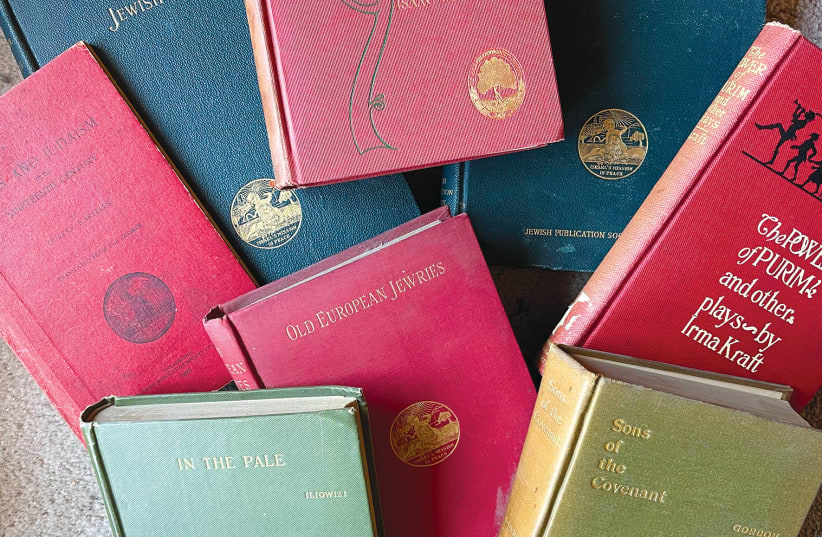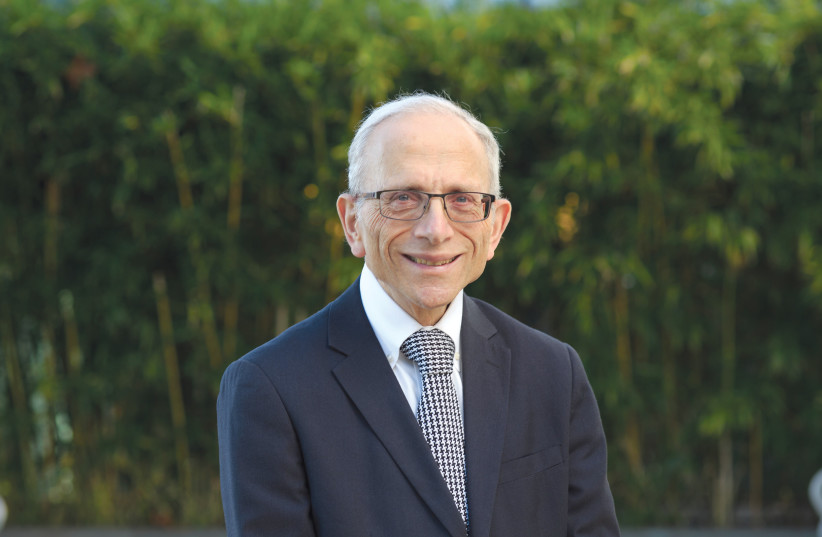In one my joyful moments growing up in Atlanta, my mother gave me a book entitled, Kasriel the Watchman and Other Stories. “You see this title?” she said. “You recall that Kasriel was your grandfather, my father?” It was the first time I held a Jewish Publication Society book and I treasured it.
My grandfather, Kasriel Birshtein, had a subscription to JPS from 1929 to the years of the Great Depression. One volume named Legends of the Jews was my favorite.
JPS published Kasriel in a series for teenagers, first printed in 1925. My copy had finger smudges all over the pages. That was my personal introduction to JPS. Now all the JPS books – more than 500 of them – will be available here in Israel.
A prominent collector, Irvin Ungar, is gifting the major set of books reflecting American Jewish cultural life in a ceremony at the University of Haifa on August 11. These are all JPS first editions beginning in 1890 through the publication of the first JPS bibliography by Joshua Bloch in 1952.
Ungar calls it “the most complete book collection in the English language of the first successful Jewish Publication Society in America.” The first Jewish publication society established in the US was founded by Isaac Leeser in Philadelphia in 1845. It published 14 booklets, entitled The Jewish Miscellany until 1850.
The main speaker at the dedication will be Prof. Jonathan Sarna, dean of American Jewish historians, who offers this insight into Ungar’s gift: “The Jewish Publication Society collection will be valuable to anyone interested in the cultural history of American Jews. From its founding in 1888 through World War I, JPS was the major publisher of Jewish books, and it helped put America on the cultural map of World Jewry.”
Sarna explains what happened subsequently. “Later, of course, JPS had much competition, but many of its books made a huge impact. Some are still in print. This is why Irvin Ungar’s gift is so important. These books are needed in Israel.”
He has an optimistic view of Jewish studies in the future: “As scholars become more interested in the history of the Jewish book, the collection will be seen as a great asset to the University of Haifa, which has emerged as the foremost program in American Jewish studies in Israel.”
“As scholars become more interested in the history of the Jewish book, the collection will be seen as a great asset to the University of Haifa, which has emerged as the foremost program in American Jewish studies in Israel.”
Prof. Jonathan Sarna
Ungar, who lives in San Francisco, has risen through the ranks of Jewish collectors in the US and in the world. As a longtime friend, I wanted to know how he put this collection together.
“After serving as a pulpit rabbi for 13 years, I entered the rare book business following the suggestion of a friend. I had all the right things going for me: 1) I had not been a collector and therefore no book collection with which to start a business; 2) I had not apprenticed with a bookseller nor studied library science or literature; 3) I had no experience to start a business; and finally 4) I had little money – all the right ingredients to start a business.”
When Ungar started collecting Jewish books, certain ones popped up repeatedly. “As I purchased Judaica book collections, there were almost always a few JPS books in the mix,” he says.
He initially did not see them as significant, so he just put them on his bookshelf. “Then I found the bibliography of Joshua Bloch, Of Making Many Books: An Annotated List of the Books issued by JPS from 1890 to 1952. I decided to see how many JPS books I had, and from there a collection evolved.”
When Ungar begins a book journey, he has certain specifications. “It had to be all first editions in very good condition, with dust jackets where possible. The collection had to have varying editions. It also had to include the relatively unknown books from the Hebrew press of JPS.”
When he read Sarna’s book, JPS: The Americanization of Jewish Culture 1888-1988, Ungar knew that he was well on the way. “I realized more fully that I was actually collecting a history of our people through the eyes of the editors of the most successful Jewish publishing house in United States. I wanted to make this collection as complete as possible – another record of American Jewry would be preserved.”
After various consultations, he decided to donate it to the University of Haifa. One reason is that it offers the Ruderman Program for American Jewish Studies established in 2012 as a joint initiative by Prof. Gur Alroey, now the Rector of the University of Haifa, between the university and Jay and Shira Ruderman’s Ruderman Family Foundation.
It covers a range of issues pertaining to American Jewish life, American society and the important bond between the Jews of America, the State of Israel and Israeli society. The program includes a 10-day field trip to the US, where participants meet American Jewish students and prominent members of the community. Graduates receive a master’s degree in Israel Studies, with a specialization in American Jewish Studies.
The Rudermans wanted to help Israelis learn more about American Jewish life. The program, which currently has 25 students, is offered as a master’s program in the Department of Israel Studies, and has grown over the past decade.
The director of the program, Dr. David Barak-Gorodesky, recently returned from two exciting years teaching at the University of Chicago Divinity School. He taught “Religion in the Israeli-Palestinian Conflict and American Peacemaking” and “Political Theologies of Zionism.”
“I was the target of a very vocal anti-Israeli campaign on campus,” he says.
He handled himself well, boosted by his experience as an academic in his former career as the vice president of a start-up called dealtime.com (which was purchased by eBay), and a former officer in the Israeli Air Force software unit.
Barak-Gorodesky earned his doctorate at the University of Haifa writing about the religious and political views of Judah Magnes, the prominent American Reform rabbi. His book on Magnes, based on his dissertation, was recently published by JPS.
The program he heads in Haifa, he says, seeks to fill the knowledge gap about American Jewry in Israel. “In the first decade of the program’s existence, we were focused mostly on introducing American Judaism to the Israeli academic and public fields.”
In the last decade, the program has developed in new directions. “Moving forward, we want to focus more on the understanding of the relationship between the two communities. We are at a critical time, in which rising polarization strains the relations between Israel and American Jewry.”
The goal now, Barak-Gorodesky says, is “to insure that the students in the program fully understand the historical evolution of the relationship and the significance of the current moment, and to be able to think and act creatively in response to the challenges we face.”
Ungar is best known for his collection of works by Jewish artist Arthur Szyk, which were purchased in 2017 by the Magnes Collection of Jewish Life and Art at the University of California at Berkeley.
“It has been a love of mine to collect the entire set of books printed by the Jewish Publication Society of America over more than 25 years,” he concludes. “I am hopeful that this generation of students and researchers, and those to follow, particularly in Israel, who are interested in American Jewish history, will take advantage of this collection.” ■
Sarna’s scholarship
Professor Jonathan Sarna, who heads the Schusterman Center for Israel Studies at Brandeis University, is in Israel this summer.
“Jewish day schools and summer camps are important and valuable, but I am worried about parents who essentially outsource Judaism to rabbis and teachers,” says Sarna. “Our two children grew up in a Jewish home where Shabbat and Yom Tov were observed, and Jewish learning was celebrated. The home atmosphere, in my view, makes a huge difference. I am so very glad that both my children observe Shabbat and Yom Tov and are raising our grandchildren in a Jewish atmosphere.”
Sarna, who has just published his latest JPS book, Coming to Terms with America: Essays on Jewish History, Religion, and Culture, is realistic about American academia today. “Admittedly, some universities in recent years have become dangerous places for Jews, which I deeply regret. But there are still universities where Jews can live rich Jewish lives even as they acquire the specialized knowledge they need to shape a career. Let’s hope those will be rewarded in the years ahead.”
As for his vision for world Jewry, Sarna says that “There are today two great centers of Jewry: Israel and North America. Between them, they amount to more than 85% of world Jewry. In a sense they have replaced the ‘Jerusalem and Babylonia’ of the Talmudic era. So it is vital that these two communities understand one another.
“Each has been shaped by its own distinctive past, which explains many of its contemporary differences with the other. Israel studies has become a significant subject in North America, and numerous books about Israel are published in English. Sadly, the study of American Jewry (except for the Ruderman Program at the University of Haifa) is weak in Israel: some colleges and universities do not teach the subject at all. As a result, Israelis know all too little about US Jewry.
“They hear only about three themes: antisemitism, assimilation and aliyah. There is much more to Judaism than that! My hope is that my scholarship – which I have worked hard to have translated into Hebrew – will help Israelis better comprehend their American Jewish cousins, including the forces that shaped American Jewish life from the 17th century to the present.”

